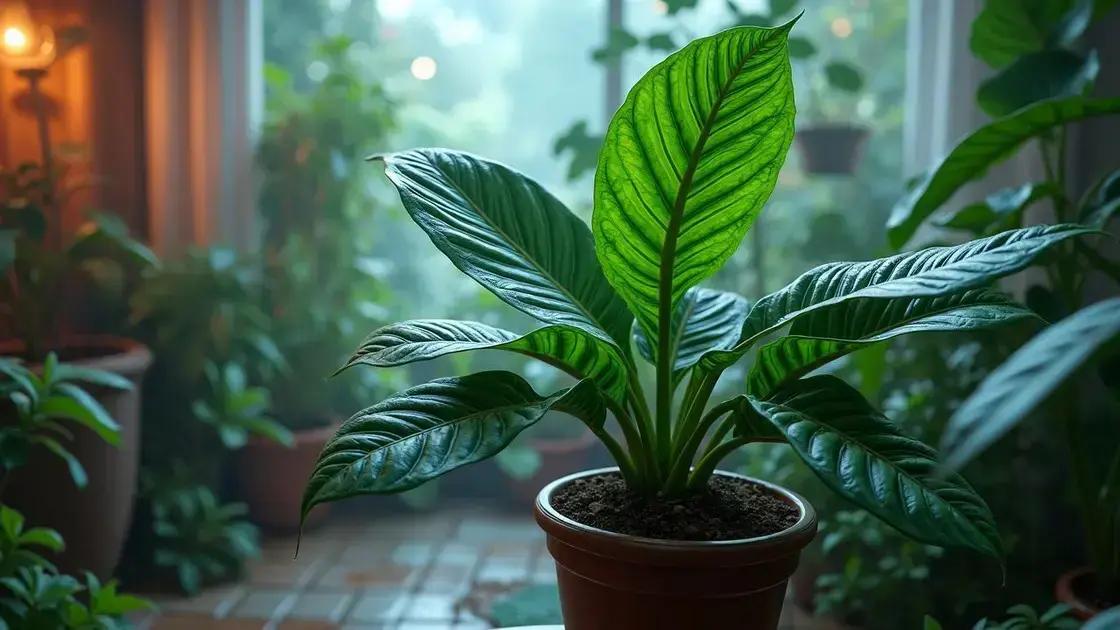How to Care for a Dieffenbachia Plant: 5 Essential Tips for Thriving Growth
How to care for a dieffenbachia plant goes beyond just watering; it involves understanding its needs. This tropical beauty can thrive indoors, making it a popular choice. Yet, many fail to realize the attention it requires. Let’s uncover the secrets to ensuring your dieffenbachia flourishes and remains a vibrant addition to your home.
Table of Contents
ToggleOptimal watering techniques for dieffenbachia care
Optimal watering techniques for dieffenbachia care are essential to maintain a healthy and vibrant plant. Proper watering helps prevent issues like root rot and promotes strong growth. Here’s how you can ensure your dieffenbachia thrives due to optimal hydration.
First, it’s crucial to know that dieffenbachia prefers consistently moist soil, but it shouldn’t be waterlogged. Finding the balance in moisture is key.
Assessing soil moisture
- Check the top inch of the soil with your finger. If it feels dry, it’s time to water.
- Always use well-draining soil to avoid water retention that can lead to root rot.
Watering frequency
Water your dieffenbachia approximately:
- Once every week during the growing season (spring and summer).
- Every 10 to 14 days in the dormant season (fall and winter).
However, these durations can vary based on factors like temperature, humidity, and the pot size.
Water quality
Use filtered or distilled water when possible to avoid chemicals found in tap water that might affect the plant’s growth. If tap water is your only option, allow it to sit out for 24 hours to let chlorine dissipate.
Pest and disease prevention
By maintaining optimal watering techniques, you’ll also minimize common dieffenbachia problems related to pests and diseases, such as:
- Root rot from overwatering.
- Mold growth from excessive humidity without proper drainage.
As part of your dieffenbachia care, regularly check for pests. If you notice signs, consider using natural pest control methods to maintain a healthy plant.
For more insights on exploring indoor gardening techniques, check out reliable gardening resources.
Conclusion
Implementing these optimal watering techniques for dieffenbachia care will allow your plant to flourish. Remember to adjust your watering schedule based on seasonal changes and environmental factors.
Light requirements and placement for healthy growth

Light requirements and placement for healthy growth are crucial elements in ensuring your dieffenbachia remains vibrant and healthy. Understanding these factors will significantly impact its overall health and growth.
Dieffenbachia plants prefer bright, indirect light but can tolerate lower light conditions. However, too little light can lead to leggy growth and poor leaf development. To keep your plant thriving, follow these guidelines:
Optimal light conditions
- Bright, indirect sunlight is ideal for dieffenbachia foliage.
- Avoid direct sunlight, which can scorch leaves.
- Places near east or west-facing windows provide suitable light conditions.
Signs of insufficient or excessive light
Monitoring your plant’s response to its light environment is essential. Here are some signs:
- Insufficient light:
- Yellowing leaves and stunted growth.
- Long, leggy stems reaching towards the light source.
- Excessive light:
- Browning leaf tips and leaf burn.
- Fading or washed-out leaf colors.
To address these issues, adjust your plant’s location or provide a sheer curtain to filter harsh rays.
Placement tips for optimal growth
- Keep your dieffenbachia away from drafts and extreme temperatures.
- Rotate the plant occasionally to promote even growth.
- Consider using grow lights if natural sunlight is insufficient.
As part of your plant care routine, consistently evaluate its light needs and re-position it as necessary to enhance its environment.
For more information on exploring indoor gardening techniques and maximizing your plant’s potential, check out additional resources.
With the right light requirements and proper placement, your dieffenbachia can thrive and remain a stunning addition to your indoor space.
Common problems and solutions for dieffenbachia plants
Common problems and solutions for dieffenbachia plants are vital for keeping your plants healthy and thriving. Understanding the potential issues and knowing how to address them will help you maintain lush foliage and prevent setbacks.
Dieffenbachia plants can encounter a variety of challenges. Here are the most common problems and how to tackle them effectively:
1. Yellow leaves
- This issue usually indicates overwatering or inadequate light.
- Solution: Check the soil moisture and ensure the plant is not in direct sunlight.
2. Drooping leaves
- Drooping often signals underwatering or extreme temperature changes.
- Solution: Water the plant thoroughly and maintain stable room temperatures between 65°F to 85°F.
3. Brown leaf tips
- This can occur due to low humidity or excessive fertilizer.
- Solution: Mist the leaves regularly or use a humidity tray and reduce fertilizer application.
4. Leggy growth
- Leggy plants indicate insufficient light.
- Solution: Move your dieffenbachia closer to a bright, indirect light source.
5. Pest infestations
- Common pests include spider mites, mealybugs, and aphids.
- Solution: Use insecticidal soap or neem oil to treat the affected areas. Regularly check your plant to avoid infestations.
To prevent these issues, regularly monitor your dieffenbachia and adjust care as needed. For an even deeper understanding, consider exploring indoor gardening techniques that provide valuable insights into plant maintenance.
By addressing these common problems and implementing the solutions provided, you can ensure your dieffenbachia stays healthy and vibrant in your home.
In conclusion
Caring for a dieffenbachia plant is a fulfilling journey that requires attention to its specific needs, from optimal watering techniques to proper light placement. By being aware of common problems and their solutions, you can ensure the long-term health and vibrancy of your plant. Remember to regularly assess its environment and adapt your care accordingly.
For more insights and tips on enhancing your indoor garden, continue exploring the beauty of indoor gardening.

